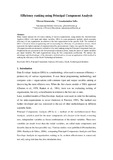| dc.contributor.author | Florou, Giannoula | |
| dc.contributor.author | Anastasiadou, Sofia | |
| dc.date.accessioned | 2020-07-28T12:33:20Z | |
| dc.date.available | 2020-07-28T12:33:20Z | |
| dc.date.issued | 2020-02 | |
| dc.identifier.uri | http://hdl.handle.net/11728/11529 | |
| dc.description | International Journal of Entrepreneurship and Innovative Competitiveness – IJEIC | en_UK |
| dc.description.abstract | Many studies analyze the efficiency ranking of various organizations, using mainly the Data Envelope Analysis (DEA) with input and output variables. DEA is a non-parametric method, which estimates efficiency of one organization in relation to the best organization in the specific field. The method of DEA is based on linear programming and on measuring the efficiency of a production process, which represents the highest amount of output produced by given amount of input, in a specific time frame.
This paper presents an alternative method of efficiency ranking using the Principal Component Analysis. Organizations are presented in the first principal component plane, using the ratios of output variables per input variables. We rank organizations using the first components coefficients. We analyze the advantages and disadvantages of the alternative method and we present an application of this method in ranking the efficiency of the Greek Technological Institutes. | en_UK |
| dc.language.iso | en | en_UK |
| dc.publisher | Research Institute for Entrepreneurship Development (RIED): Neapolis University, Pafos | en_UK |
| dc.relation.ispartofseries | International Journal of Entrepreneurship and Innovative Competitiveness – IJEIC;vol. 2, issue 1, February 2020 | |
| dc.subject | Research Subject Categories::SOCIAL SCIENCES::Business and economics | en_UK |
| dc.subject | DEA | en_UK |
| dc.subject | Principal Components Analysis | en_UK |
| dc.subject | Efficiency | en_UK |
| dc.subject | Greek | en_UK |
| dc.subject | Technological Institutes | en_UK |
| dc.title | Efficiency ranking using Principal Component Analysis | en_UK |
| dc.type | Article | en_UK |

